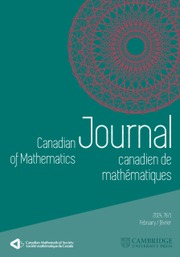Article contents
On the Curves Associated to Certain Rings of Automorphic Forms
Published online by Cambridge University Press: 20 November 2018
Abstract
In a 1987 paper, Gross introduced certain curves associated to a definite quaternion algebra  $B$ over
$B$ over  $\mathbf{Q}$ ; he then proved an analog of his result with Zagier for these curves. In Gross’ paper, the curves were defined in a somewhat ad hoc manner. In this article, we present an interpretation of these curves as projective varieties arising from graded rings of automorphic forms on
$\mathbf{Q}$ ; he then proved an analog of his result with Zagier for these curves. In Gross’ paper, the curves were defined in a somewhat ad hoc manner. In this article, we present an interpretation of these curves as projective varieties arising from graded rings of automorphic forms on  ${{B}^{\times }}$ , analogously to the construction in the Satake compactification. To define such graded rings, one needs to introduce a “multiplication” of automorphic forms that arises from the representation ring of
${{B}^{\times }}$ , analogously to the construction in the Satake compactification. To define such graded rings, one needs to introduce a “multiplication” of automorphic forms that arises from the representation ring of  ${{B}^{\times }}$ . The resulting curves are unions of projective lines equipped with a collection of Hecke correspondences. They parametrize two-dimensional complex tori with quaternionic multiplication. In general, these complex tori are not abelian varieties; they are algebraic precisely when they correspond to
${{B}^{\times }}$ . The resulting curves are unions of projective lines equipped with a collection of Hecke correspondences. They parametrize two-dimensional complex tori with quaternionic multiplication. In general, these complex tori are not abelian varieties; they are algebraic precisely when they correspond to  $\text{CM}$ points on these curves, and are thus isogenous to a product
$\text{CM}$ points on these curves, and are thus isogenous to a product  $E\,\times \,E$ , where
$E\,\times \,E$ , where  $E$ is an elliptic curve with complex multiplication. For these
$E$ is an elliptic curve with complex multiplication. For these  $\text{CM}$ points one can make a relation between the action of the
$\text{CM}$ points one can make a relation between the action of the  $p$ -th Hecke operator and Frobenius at
$p$ -th Hecke operator and Frobenius at  $p$ , similar to the well-known congruence relation of Eichler and Shimura.
$p$ , similar to the well-known congruence relation of Eichler and Shimura.
Keywords
Information
- Type
- Research Article
- Information
- Copyright
- Copyright © Canadian Mathematical Society 2001
References
- 1
- Cited by

